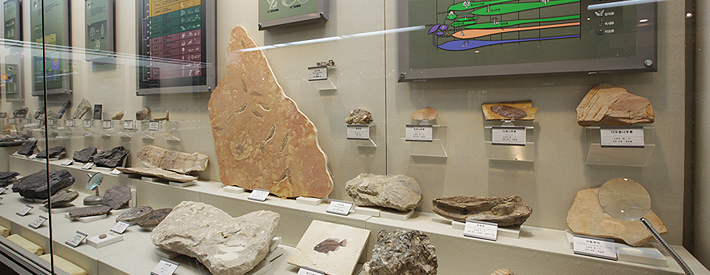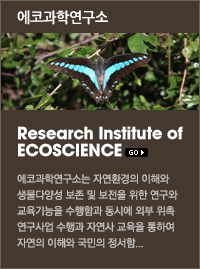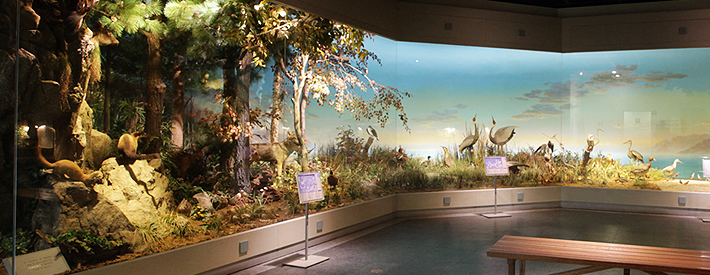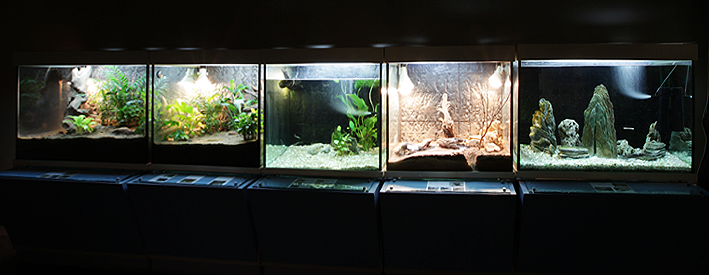Exhibition

 |
 |
 |
 |
 |
 |
 |
|---|---|---|---|---|---|---|
|
|
||||||
 |
 |
 |
 |
 |
 |
 |
|---|---|---|---|---|---|---|
|
|
||||||
 |
 |
 |
 |
 |
 |
 |
|
|---|---|---|---|---|---|---|---|
|
|
|||||||
| Samples of diverse plants, including sea algae, are displayed with the picture of vivid ecosystem and life-size models with descriptions. Also, medicinal and resource plants are exhibited using models and seeds. And the specimen of naturalized plants are also displayed. |
Exhibitions
Endemic plants/ Naturalized Plants and Environmental Preservation/ Plant Resources/ Reproduction of Plants/ Dispersal of the Plant Seed.
Plants...
Plants, with animals, form an enormous ecosystem. Since the time plants emerged on Earth, they have continually evolved from an unknown primitive plant species and present day they made a world of diverse plants with over 300,000 species. Plants show remarkable rate of adaptation as they exist in every environment on Earth and became the basic of the foodchains of all the terrestrial animals.
Moreover, humans have used them not only for food but clothing, shelter, weapons, tools, dyes, medicines and for many other purposes.
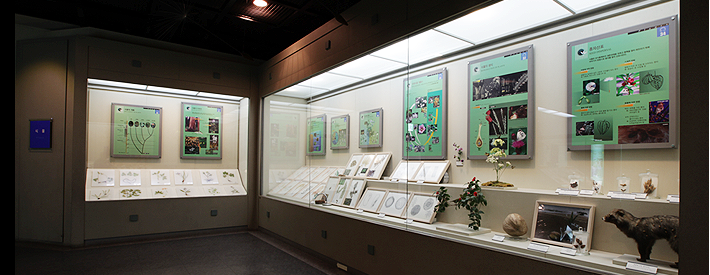
 |
 |
 |
 |
 |
 |
 |
|
|---|---|---|---|---|---|---|---|
|
|
|||||||
| In this section diverse insects are displayed according to their phylogeny. The structures and characteristics, metamorphosis and ecdysis are clearly described. Also, rare insects, East-Asia insects, and various tools to collect the insects are exhibited. Exhibitions Body Structures and Characteristics/ Metamorphosis and Ecdysis/ Insects in Group/ Aquatic Insects/ Rare Insects of Korea Insects... Insects are divided into two classes: Pterygota(insects with wings) and Apterygota(insects without wings). Insect emerged about 400 million years ago, and the Pterygota such as dragonflies, mayflies, cockroaches emerged about 300 million years ago. Insect is the biggest biota with almost 900 thousand species, making up 75% of the animals |
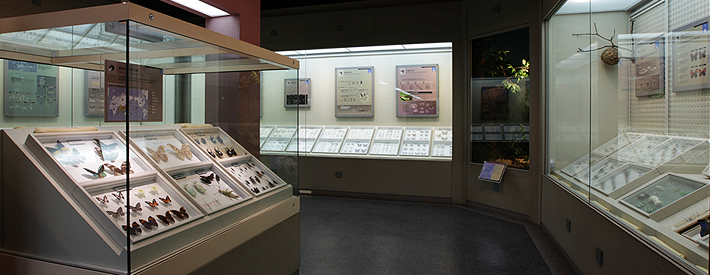
 |
 |
 |
 |
 |
 |
 |
|
|---|---|---|---|---|---|---|---|
|
|
|||||||
| • In this section the samples in each phylum from protozoans to chordates are displayed with each specimens, panels, pictures, and drawings to help understand the distinct characteristics. Dry- specimen and alcohol-preserved-specimen are displayed, and fun stories of rare marine specimens including the corals with diverse shape, red tide phenomena, dangerous marine animals, mimesis and camouflage, and symbioses etc can be seen. Exhibitions Poriferan/ Nematocyst/ Coral and Coral Reef/ Mollusk/ Arthropod/ Echinoderm Invertebrates... Invertebrate is composed of animals without the vertebra or endoskeletal structure. About 96% of all animals are invertebrates. Invertebrates are divided into many phyla, from unicellular protozoans to multicellular poriferan, mollusk, arthropod, and chordates phylum. These separated phyla show distinctively diverse forms and developments. |
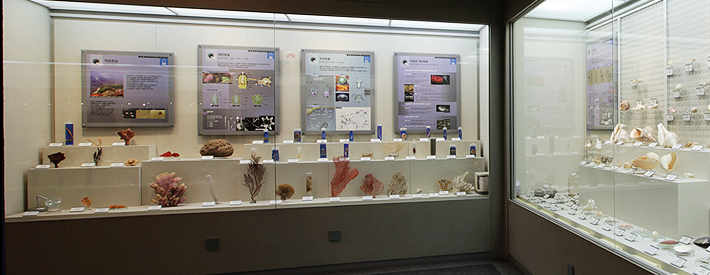
 |
 |
 |
 |
 |
 |
 |
|
|---|---|---|---|---|---|---|---|
|
|
|||||||
| In this section fish, reptilian, amphibian, bird, and mammals are displayed. Fishes are divided into jawless fish and jaw fish with each specimen’s characteristic and panel. Independently displayed amphibians are described with the specimen and its’ developmental stage preserved in alcohol. The life-size wooden model of the extinct crested shelduck is also displayed and precious and diverse foreign reptiles, resident birds, migratory birds, internationally protected birds, and mammals are exhibited to help understand the ecological characteristics. Exhibitions Fish/ Amphibia/ Reptilia/ Birds/ Mammals/ Resident Birds and Migratory Birds/ Internationally Protected Birds/ Platypus/ Bird's Nest Vertebrates... Vertebrates have the most complicated system with differentiated functions such as vertebra and endoskeletal structure, efficient and developed nerve system, respiratory system, and organ system. Animals in this group are divided into two: fish kind(pisces) and tetrapods(amphibians, reptiles, birds, and mammals). |
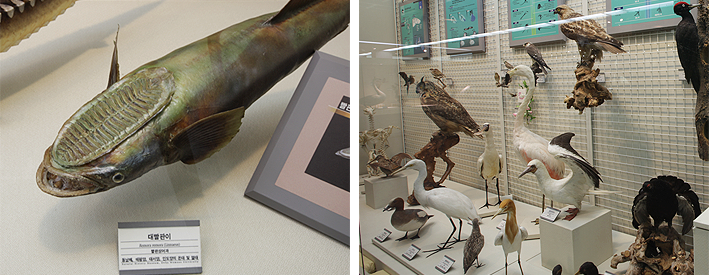
 |
 |
 |
 |
 |
 |
 |
|
|---|---|---|---|---|---|---|---|
|
|
|||||||
| In this sections, minerals, rocks, and fossils are on display according to various subjects. Especially the meteoric stones, continental drift theory, jewelry stones, history of dinosaurs, fluorescent minerals, and microfossil sections will interest one about the Earth. Also, the video theatre provides documentaries on the universe and it will satisfy one’s interest in it. Exhibitions Minerals/ Rocks/ Fossils/ Meteoric Stones/ Jewelry Stones/ Continental Drift Theory/ The History of Dinosaur/ Microfossil/ Fluorescent Mineral/ Theatre |
Minerals...
Minerals are solid materials with chemical components and crystal structure constantly produced from nature
Rocks...
Rocks are classified as igneous rock, sedimentary rock, and metamorphic rock according to the process each are produced
Fossils...
Fossils are the preserves of animals’ and plants’ bodies that were buried into strata.
